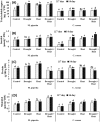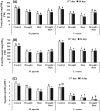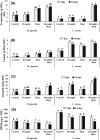Changes in Ecophysiology, Osmolytes, and Secondary Metabolites of the Medicinal Plants of Mentha piperita and Catharanthus roseus Subjected to Drought and Heat Stress
- PMID: 31892111
- PMCID: PMC7023420
- DOI: 10.3390/biom10010043
Changes in Ecophysiology, Osmolytes, and Secondary Metabolites of the Medicinal Plants of Mentha piperita and Catharanthus roseus Subjected to Drought and Heat Stress
Abstract
Global warming contributes to higher temperatures and reduces rainfall for most areas worldwide. The concurrent incidence of extreme temperature and water shortage lead to temperature stress damage in plants. Seeking to imitate a more natural field situation and to figure out responses of specific stresses with regard to their combination, we investigated physiological, biochemical, and metabolomic variations following drought and heat stress imposition (alone and combined) and recovery, using Mentha piperita and Catharanthus roseus plants. Plants were exposed to drought and/or heat stress (35 °C) for seven and fourteen days. Plant height and weight (both fresh and dry weight) were significantly decreased by stress, and the effects more pronounced with a combined heat and drought treatment. Drought and/or heat stress triggered the accumulation of osmolytes (proline, sugars, glycine betaine, and sugar alcohols including inositol and mannitol), with maximum accumulation in response to the combined stress. Total phenol, flavonoid, and saponin contents decreased in response to drought and/or heat stress at seven and fourteen days; however, levels of other secondary metabolites, including tannins, terpenoids, and alkaloids, increased under stress in both plants, with maximal accumulation under the combined heat/drought stress. Extracts from leaves of both species significantly inhibited the growth of pathogenic fungi and bacteria, as well as two human cancer cell lines. Drought and heat stress significantly reduced the antimicrobial and anticancer activities of plants. The increased accumulation of secondary metabolites observed in response to drought and/or heat stress suggests that imposition of abiotic stress may be a strategy for increasing the content of the therapeutic secondary metabolites associated with these plants.
Keywords: Catharanthus roseus; Mentha piperita; drought; heat stress; secondary metabolites.
Conflict of interest statement
The authors declare no conflict of interest.
Figures




References
-
- Jakada B.H., Aslam M., Fakher B., Greaves J.G., Li Z., Li W., Lai L., Ayoade O.A., Cheng Y., Cao S., et al. Identification of SWI2/SNF2-Related 1 Chromatin Remodeling Complex (SWR1-C) Subunits in Pineapple and the Role of Pineapple SWR1 COMPLEX 6 (AcSWC6) in Biotic and Abiotic Stress Response. Biomolecules. 2019;9:364. doi: 10.3390/biom9080364. - DOI - PMC - PubMed
MeSH terms
Substances
LinkOut - more resources
Full Text Sources

